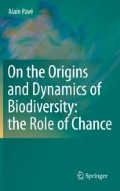Abstract
Making hypotheses and conjectures is an integral part of the scientific approach, and perhaps the principal one. Providing proof is essential, but it is at least as important to examine the practical consequences. If we highlight the importance of the spontaneous, random processes in living systems resulting from endogenous mechanisms, it is because they must be taken into account. So, and in these cases, managing them could be made simpler and more effective. It is even possible that, in certain cases, it is in our interest to improve the efficaciousness of the processes that create randomness; for example, to increase the pace of diversification or to improve the conditions that preserve biodiversity.
Values and knowledge are always and necessarily associated in action just as in discourse.
Jacques Monod, 1971
Access this chapter
Tax calculation will be finalised at checkout
Purchases are for personal use only
Notes
- 1.
We particularly note the use of the concepts and mathematical models coming out of ecology to better understand the processes by which an organism is infected with HIV. The articles by Wei et al. (1995) on the one hand, and by Ho et al. (1995) on the other, thoroughly questioned the hypothesis, which was then current, on the “furtiveness” of the virus. On the same subject, we could equally consult the article by Nowack et al. (1995). It is important to note that in the list of authors there are “modelers” known for their work in ecology and population dynamics. This category of scientists has broken with studies on the interfaces between disciplines, rich in concepts and methods. Consequently, they are also good “border crossers”.
- 2.
The ecological term is not used here, or in the rest of this book, in its ideological or emotional sense, but in a strictly scientific sense. We can also speak of engineering ecological systems or of a “new” agronomy that widely integrates the knowledge and concepts of ecology: agro-ecology.
- 3.
Latinised neologism used in the literature for that which concerns computer science. In this case, it concerns databases of genetic sequences.
- 4.
Selection can be borne by several characters. It is also possible that a selection judged to be positive for a character or a group of characters can be “counter-selected” by others. Thus, it is thought that the selection of bovines for milk and meat production has had a negative influence on their ability to live without humans.
- 5.
These bacteria have genetic handicaps to avoid possible proliferation outside of confined environments.
- 6.
In this book, as was stated in the foreword, we have only alluded to problems, other than biological and ecological, concerning biodiversity. There are already many books on these subjects, but an overall and objective synthesis would be of great interest. The role of social movers and shakers, the analysis of avowed and unavowed interests, deserve that we stop a moment much as Catherine Aubertin did for biodiversity by coordinating the following book: Représenter la nature ? ONG et biodiversité, Editions IRD, Paris, 2005. On another level, we could benefit from – and find pleasure in – reading the book by Erik Orsenna: Voyage aux pays du coton – Petit précis de mondialisation, Fayard, 2006.
- 7.
This paragraph was written after discussions with Alain Dejean, an internationally renowned expert on social insects, and with Pierre Charles-Dominique, an equally well-known ecologist.
- 8.
- 9.
The term “law” (of nature), which was bothering me, now seems to me to be well adapted to the idea of the limits of the possibilities of the action that it implies.
References
Barbault R., Pavé A., 2003, Écologie des territoires et territoires de l’écologie. In Caseau P. (Ed), Études sur l’environnement: du territoire au continent. RST, Académie des sciences, Tech&Doc, Paris, 1–49.
Caseau P. (Ed.), 2003, Études sur l’environnement- De l’échelle du territoire à celle du continent. Rapport sur la science et la technologie, Académie des Sciences, Tech&Doc, Lavoisier, Paris, (Summary in English).
Monod J., 1971, Chance and Necessity. An Essay on the Natural Philosophy of Modern Biology. A.A. Knopf, New York, NY.
Pelletier E., Campbell P., 2008, L’écotoxicologie aquatique – comparaison entre les micropolluants organiques et les métaux: constats actuels et défis pour l’avenir. Revue des sciences de l’eau, 21, 173–197.
Steinberg C.W., Ade M., 2005, Ecotoxicology, Where do you come from and Where do you go? Environmental Science and Pollution Research, 12, 245–246.
Van Straalen N., 2003, Ecotoxicology becomes stress ecology. Environmental Science and Technology, 37(17), 324A–330A.
Author information
Authors and Affiliations
Corresponding author
Rights and permissions
Copyright information
© 2010 Springer Science+Business Media, LLC
About this chapter
Cite this chapter
Pavé, A. (2010). Lessons for Managing Living Systems. In: On the Origins and Dynamics of Biodiversity: the Role of Chance. Springer, New York, NY. https://doi.org/10.1007/978-1-4419-6244-7_3
Download citation
DOI: https://doi.org/10.1007/978-1-4419-6244-7_3
Published:
Publisher Name: Springer, New York, NY
Print ISBN: 978-1-4419-6243-0
Online ISBN: 978-1-4419-6244-7
eBook Packages: Biomedical and Life SciencesBiomedical and Life Sciences (R0)

